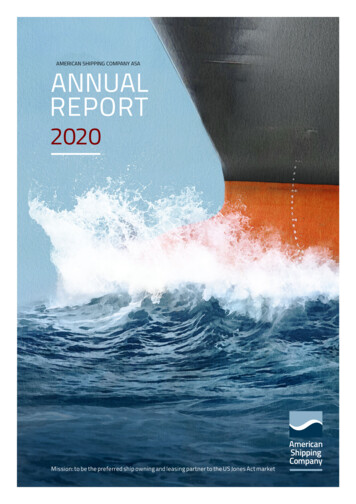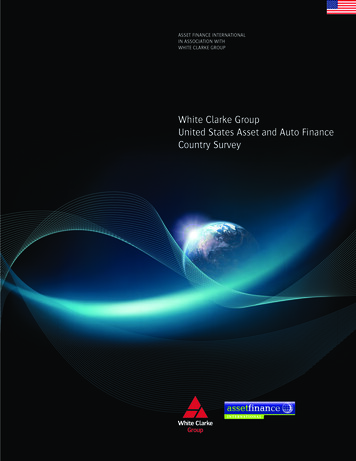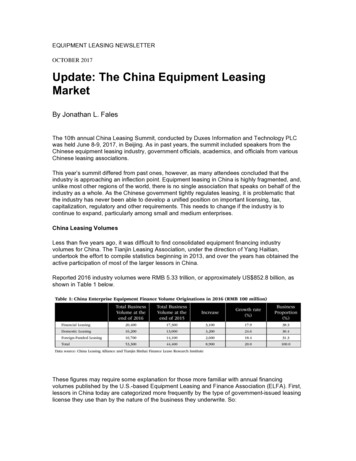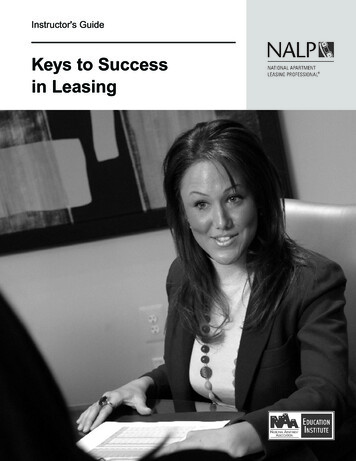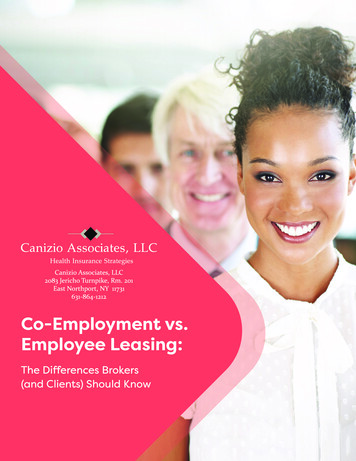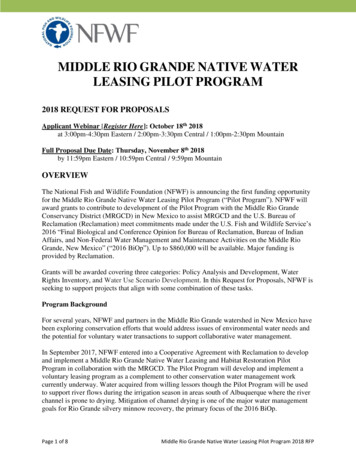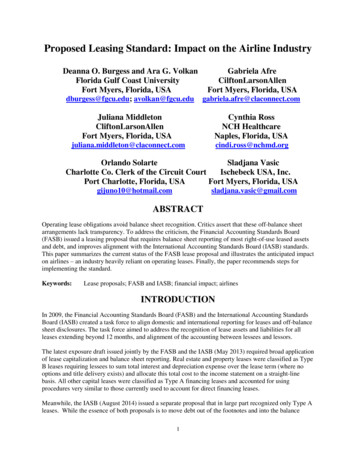
Transcription
Proposed Leasing Standard: Impact on the Airline IndustryDeanna O. Burgess and Ara G. VolkanFlorida Gulf Coast UniversityFort Myers, Florida, USAGabriela AfreCilftonLarsonAllenFort Myers, Florida, USAdburgess@fgcu.edu; a MiddletonCliftonLarsonAllenFort Myers, Florida, USACynthia RossNCH HealthcareNaples, Florida, d.orgOrlando SolarteSladjana VasicCharlotte Co. Clerk of the Circuit CourtIschebeck USA, Inc.Port Charlotte, Florida, USAFort Myers, Florida, TRACTOperating lease obligations avoid balance sheet recognition. Critics assert that these off-balance sheetarrangements lack transparency. To address the criticism, the Financial Accounting Standards Board(FASB) issued a leasing proposal that requires balance sheet reporting of most right-of-use leased assetsand debt, and improves alignment with the International Accounting Standards Board (IASB) standards.This paper summarizes the current status of the FASB lease proposal and illustrates the anticipated impacton airlines – an industry heavily reliant on operating leases. Finally, the paper recommends steps forimplementing the standard.Keywords:Lease proposals; FASB and IASB; financial impact; airlinesINTRODUCTIONIn 2009, the Financial Accounting Standards Board (FASB) and the International Accounting StandardsBoard (IASB) created a task force to align domestic and international reporting for leases and off-balancesheet disclosures. The task force aimed to address the recognition of lease assets and liabilities for allleases extending beyond 12 months, and alignment of the accounting between lessees and lessors.The latest exposure draft issued jointly by the FASB and the IASB (May 2013) required broad applicationof lease capitalization and balance sheet reporting. Real estate and property leases were classified as TypeB leases requiring lessees to sum total interest and depreciation expense over the lease term (where nooptions and title delivery exists) and allocate this total cost to the income statement on a straight-linebasis. All other capital leases were classified as Type A financing leases and accounted for usingprocedures very similar to those currently used to account for direct financing leases.Meanwhile, the IASB (August 2014) issued a separate proposal that in large part recognized only Type Aleases. While the essence of both proposals is to move debt out of the footnotes and into the balance1
sheet, the FASB proposal accomplishes this in two categories while the IASB proposal uses only one.Both proposals require a right-of-use (ROU) model that classifies most operating leases as debt on thebalance sheet along with the assets associated with their right-of-use. In the remainder of this paper, theFASB proposal will be the main focus.PURPOSEThere is no argument that the main objective of the proposals is to shift lessee debt into the balance sheetand out of the footnotes. Companies reliant on operating leases are heavily impacted by this standardbecause debt formerly nestled in the footnotes will be added to their balance sheets. Accordingly, thispaper illustrates the financial consequences of this proposal on the airline industry – a sector heavilyreliant on operating leases. Guidance for companies transitioning toward implementation of the proposalis provided along conclusions and implications for future research.This study is relevant to all sectors of the economy, including governmental and professional sectors, dueto the far-reaching implications of this proposal involving debt associated with leases that will either bemoved out of the footnotes and into the balance sheet, or expensed when paid at amounts greater thanpreviously required. For many entities, the accounting changes will have an adverse impact on financialstatements and general credit conditions. In addition, companies will spend significant resourcesoverhauling their accounting systems and legal contracts.As an illustration for companies outside the airline sector analyzed in this paper, the effects of thisproposal may be significant for large retailers like Walgreen’s, Target, and Kohl. Walgreen’s leases morethan 8,000 drugstore properties and reports approximately 35 billion of operating leases currentlyavoiding balance sheet recognition. While the proposed lease accounting will have little impact onWalgreen’s profits (lease expense will remain mostly unchanged when shifting from operating leases toType B real-estate leases under the new standard), the debt/equity ratio will increase and the companywill experience an elevated risk profile. Riley and Shortridge (2013) predict debt will increase 16% forTarget and 66% for Kohl. Target’s current ratio will decrease by 1% and Kohl’s by 8%. Similarly, thechanges in solvency ratios for Kohl’s will be very large. The company’s debt/equity ratio would increasefrom 0.64 to 1.06 (66% increase) and return on assets would decline by 13%. These large shifts mayrepresent significant concerns for creditors and investors, despite the fact that no contracts are altered andthe economic circumstances of both companies remain unchanged.On a broader scale, in Europe, outstanding leases totaled 928 billion in 2011. In 2012, United Statescompanies had about 1.5 trillion of operating leases, with real estate leases making up about 1.1 trillionof the total. The accounting for many of these leases will change with this proposal. Reporting additionallease liabilities on the balance sheet may breach corporate loan covenants or trigger credit rankingchanges. In sum, all businesses, governmental organizations, and accounting firms should haveknowledge of the economic impact of the new rules and prepare for their implementation to make thetransition process smoother.THEORETICAL AND TECHNICAL ISSUESThe latest FASB lease proposal focuses on assets that can be explicitly or implicitly identified, either asseparate assets or physically distinct portions of assets that the lessee has exclusive use. In the past, onlylong-term property, plant and equipment leases were subject to capitalization. The new proposal widensthe number of leases requiring capitalization by broadening the type of assets covered by the standard. Inaddition, the proposal suggests a new probability test that will result in the inclusion of renewal periods inthe computation of the lease term. Purchase options are considered similar to renewal options.2
The proposal covers contracts that convey a right-of-use and control of an asset for a period of 12 monthsor longer. Control is conveyed when parties exchange rights to direct and obtain benefits from the asset’suse. While the timing of the implementation of the new proposal is unknown, it is expected that both theFASB and the IASB will issue their final standards sometime this year. In May 2014, speaking at the 13thAnnual Baruch College Financial Reporting Conference, the FASB Technical Director, Susan Casper,forecasted the new rules may be issued in 2015 and be effective in 2017. In the latest joint meeting of theFASB and IASB on January 21, 2015, the Boards recommended revised disclosures assessing the nature,timing and uncertainty of lease related cash flows. Additional joint meetings may yet occur before thestandards are finalized.As specified above, asset capitalization under the current proposal applies to long-term leasearrangements of almost all types of assets with a lease term (including renewals and extensions) of 12months or longer. Renewal periods may make the difference between classifying a lease as a capital lease(12 months or longer) or an operating lease (less than 12 months). This probability test focuses onsignificant economic incentives that may lead a lessee to use renewal options (Boyle et al, 2014). Thus,renewal periods of one year or less with large termination penalties are included when calculating theterm of the lease. For example, the proposal capitalizes a typical fleet/split lease for less than 12 months,with month-to-month renewals carrying significant penalties for failure to renew.The proposal excludes the following lease arrangements:* Short-term leases of 12 months or less with low penalties for failure to renew;* Leases of intangibles;* Leases for the right to explore and use non-regenerative resources;* Leases of timber and other biological assets; and* Leases of service concessions arrangements.Should the market reaction to this standard increase demand for short-term leases to avoid capitalization,lessees will report less debt, and lessors will convey fewer assets (Craig, 2013). In addition, these shortterm leases will reduce the predictability of cash flows for readers of the financial statements byshortening the duration of cash flows and therefore diminishing the ability to refine economicexpectations over an expanded horizon. This paper outlines the new rules and illustrates the estimatedimpact on airlines.CURRENT LEASE CAPITALIZATION RULESDomestic and international lease standards require similar procedures for the capitalization of leases, asdescribed in Table 1. Both standards use similar language to define a lease as an arrangement conveyingthe right to use an asset for an agreed time period. In addition, both standards use similar concepts forcapitalization.In practice, the four FAS13 criteria for capitalization (referred to as bright-line tests) are often used tointerpret the IAS17 indicators. With both standards, be advised that a lessee and lessor may classify thesame lease differently. For example, if the lessee unknowingly uses a higher interest rate than the lessor,the lessee may avoid capitalization and the lessor will not. The major changes in the new proposals arethe elimination of bright-line rules (e.g., 75% of useful life, 90% of fair market value) and thecapitalization of all leases covering more than 12 months.3
Table 1: Main Characteristics of Domestic and Global Lease AccountingFAS13Capitalization as a Direct Financing Lease ifarrangement transfers substantially the risks andbenefits of ownership. Required if any of the followingare met for a Lessee (Lessor must also assure that nouncertainties exist and collection is assured):Transfer of titleBargain purchase optionLease term is 75% or more of the asset’s lifeIAS17Capitalization as a Finance Lease if arrangementtransfers substantially the risks and benefits ofownership. Required if any of the following are met:Transfer of titleBargain purchase optionLease term is the major part of the leased asset’s usefullifePresent value of the minimum lease payments is equalto substantially all of the leased asset’s valueThe asset is of a specified natureLessee guarantees the lessor’s investment if the lesseecancels the leaseLessee receives residual upside and bears the residuallosses at lease-endBargain renewal optionsPresent value of the minimum lease payments is 90%or more of the asset’s fair market valueFASB LEASE PROPOSAL: AN ACCOUNTING EXAMPLEThe FASB lease proposal recognizes two types of leases (Types A and B leases) and the IASBproposal recognizes only one (essentially equivalent to Type A leases). The FASB proposal is ahybrid of existing domestic and international practices. For lessees, all leases that are twelvemonths or longer are added to the balance sheet to conform to the international practice ofcapitalization and are expensed over time. The convergence ends at this point: Type B leases areexpensed using one expense account (similar to traditional operating leases), and Type A leasesare expensed using two-line items of interest and amortization (resembling domestic DirectFinancing leases and all global IASB leases).Type A and B lease accounting is summarized in Illustration 1 using a five (5) year lease at 8%interest, with the first payment due at inception. Data used in this example is adapted fromLightner et al (January 2013). When measuring assets and liabilities arising from a lease, thelessee and the lessor exclude most variable lease payments. In addition, a lessee and a lessorinclude payments to be made in optional periods if the lessee has a significant economicincentive to exercise an option to extend the lease or not to exercise an option to terminate thelease (Lightner et al, September, 2013).Illustration 1: Accounting for Type A and B Leases Under the FASB ProposalPanel A – FactsAsset CostAsset Gross ProfitAsset Fair Market ValueLease paymentsPV of Lease PaymentsPV of Lease Residual InterestTotal PVOther information: 580,000 20,000 [ 14,896 (74.5%) recognized and 5,104 (25.5%) deferred–see below] 600,000 103,631 446,869 (74.5% of fair value) 153,131 (25.5% of fair value) (unguaranteed residual value) 600,000 (100.0%)No title passing; no options; no renewals; no initial direct costs4
Type A Lease Expense (two items):Interest (first year) 27,459 ( 446,869- 103,631)*.08 [Note:Principal reduction (first year) 76,172(total payment - 27,459 interest)] 89,374 per year 116,833Depreciation (straight-line)First Year Expense:Type B Lease Expense (one item – same each year):Depreciation (straight-line) 89,374 per year ( 446,869 for 5 years)Interest expense each year 14,257[total interest over 5 years 71,286:5]S-L expensing of interest and depr.for lessee (type B lease) 103,631Panel B - Lessee AccountingProposed LesseeAccounting for Rightof Use (ROU) AssetsBalance SheetReportingIncome StatementReportingType A Leases: Same as mostexisting Capital Leases involvingmost leases other than real estaterequiring interest and 446,869 ROU asset and debtmeasured using present value oflease payments.Interest (measured by the effectiveinterest method) and assetamortization reported separately.Type B Leases: Same as most existingOperating Leases involving real estatethat require straight-line expensing 446,869 ROU asset and debt measured usingpresent value of lease payments. 103,631 combined interest and assetamortization reported as one line-item.Panel C - Lessor AccountingProposed LessorAccounting forRight of Use(ROU) AssetsBalance SheetReportingIncome StatementReportingType A Leases: Same as existing DirectFinancing/Sale-Type Leases involving most leasesother than real estateRemove the underlying asset and replace it with anet receivable (net of deferred interest) and aresidual asset to total 600,000.Recognize 14,896 guaranteed portion of grossprofit and defer the rest. Recognize interest incomeover the lease term (using effective interest method).Do not depreciate the residual asset.Type B Leases: Same as existingOperating Leases involving realestateContinue to recognize the entireunderlying asset.Recognize lease income over thelease term typically on a straightline basis.ESTIMATED IMPACT ON THE AIRLINE INDUSTRYAnticipated changes with this new proposal will be felt by nearly every member of the domestic airlineindustry due to the industry’s heavy reliance on operating leases that will shift to balance sheetrecognition with adoption of this standard. This paper illustrates the financial consequences of this leaseproposal to the financial statements of six domestic carriers with operating lease exposures measured as apercentage of total assets at 2011 amounts ranging from (least to most) – 1) Jet Blue (22% operatingleases to total assets); 2) Alaska Air (23%); 3) United Continental Holdings (25%); 4) Republic (42%); 5)US Air (46%); and 6) Sky West (70%).The financial statements are restated for all six carriers illustrating the implementation of the proposedstandard (see Appendix). Resulting differences from implementation of the standard are analyzed by firstcomputing the net present value (NPV) of the operating lease obligations, as proposed by Grossman and5
Grossman (2010). The short term lease payments are assumed to range from one to four years and thefifth-year lease payments are assumed to be constant over the remaining life of the lease. Similar longterm obligations are assumed to occur during the 1-4 year short-term period (Durocher, 2008; Ericksonand Trevino, 1994). The discount rate used in NPV calculations of each company is calculated bydividing the company’s interest expense by its total debt (Durocher and Fortin, 2009).To illustrate, Exhibit 3 reports restated data for United Continental Holdings representing a low operatinglease carrier. Using a calculated internal interest rate of 7.45%, the NPV of the minimum lease paymentswas determined to be 15,367 (all amounts are in millions of dollars). This amount is added to the assetside of the balance sheet (adjusted for additional deferred tax assets of 94 and reduced by 1,397amortization) resulting in a pro-forma increase in total assets of 14,064 ( 37,988 to 52,052). The sameNPV of the minimum lease payments adds to the liability portion of the balance sheet because it is used torecord the company’s additional indebtedness. The liability is reduced by 1,128 representing theprincipal repayment of the lease obligations in the current year. Therefore, the proposed regulations willincrease the total liabilities for United Continental Holdings from 36,182 to 50,420 (39%).As to be expected, the impact on wealth is also unfavorable. Replacing 2,274 operating lease expensewith an increase in 1,397 depreciation expense and 1,145 interest expense, results in a decrease inprofits of 268. After taxes, this amounts to a reduction in wealth of 174 (21% reduction). Thus,Exhibits 1 through 6 confirm that the proposed standard may significantly impact financial ratios in leaseprone industries. Nearly all airline carriers studied report an increase in their debt-to-equity ratio,demonstrating an increase in risk, and a worsening of the return on assets as summarized in Table 2.Table 2: Illustration of Impact of Standard on Key Ratios of the Airline IndustryAirlines (ranked from lowest tohighest operating lease exposure)Jet BlueAlaska AirUnited Continental HoldingsRepublicUS AirSky West Inc.Debt to Equity Percentage Increase(Decrease) with the Implementationof Standard20%51%135%47%(17%)117%Return on Assets PercentageIncrease (Decrease) with theImplementation of Standard(11%)(14%)(27%)(20%)(11%)(33%)At present, the probability of a issuing a converged standard is slight. FASB support is fragile. The 2013exposure draft cleared the board by just a 4-3 vote. Since that time, the FASB elected a new chair and oneof the board members who supported the proposal has been replaced. Leasing industry lobbying groupsand a coalition led by the U.S. Chamber of Commerce and real estate groups are opposing the standard.These opponents secured allies in Washington. Sixty members of Congress asked the standard-setters lastyear to rethink the rules.TRANSITIONThe rules may become effective on January 1, 2017 or later. The proposed transition rules require lesseesto capitalize their operating leases by discounting the remaining lease payments at their incrementalborrowing rate. If an existing operating lease is determined to be Type B, the ROU asset recorded at thetransition date will equal the liability added to the balance sheet.For Type A leases, the ROU will be measured based upon the lease payments remaining at thecommencement date. For example, assume that a 10-year lease originally treated as an operating lease hasseven years remaining at the transition date. If the lessee estimates that the present value of the liability at6
the commencement date was 10,000, the ROU asset will be recorded at 7,000 at the date of transition( 10,000 multiplied by 70% remaining life). Furthermore, assuming that the present value of theremaining lease payments at the transition date was 8,000, the lessee would recognize a 7,000 asset, an 8,000 liability, and a 1,000 debit adjustment to retained earnings.Companies with significant lease exposure need advice to take (or, not to take) action. Should theyrenegotiate, maintain, or replace their lease contracts? Best practices can be summarized as follows(Chambers et al, 2015; Wheeler et al, 2013):1. Compile a complete inventory of leases.2. Identify any additional required terms and accounting assumptions.3. Determine if existing systems meet the measurement and reporting requirements of:a. Lease classificationb. Residual value accretionc. Fair value determinationd. Sale profit allocatione. Initial direct cost accountingf. Segregation of lease and service paymentsg. Taxes4. Measure the impact on processes and people:a. Expenditures move from operating to capitalb. Decision-making moves towards the CFOc. Lessor sales systems need to provide more information for decision-making.d. A sales car fleet may require changes in supervision of accounting from human resources tofacilities.e. New product opportunities.5. Centralize leasing operations and administration.CONCLUSIONS & SUGGESTIONS FOR FUTURE RESEARCHBoth U.S. and international lease accounting standards are likely to change. One of the most importantchanges will be the addition of a number of right-to-use assets and lease liabilities on lessees’ balancesheets. In addition, expense recognition patterns and lease disclosures are poised to change and moreexpense will be recognized under Type A leases than are currently recognized under direct financingleases. Some lessees could experience significant impacts to their financial statements under the newlease accounting standard as illustrated among the airline carriers. Companies with significant leaseexposure should prepare for the new rules by following the steps described above. Knowledge of the newrules and careful preparation for the proposed standard will make the transition process smoother.While the study demonstrates the adverse impact of the proposals on the airline industry, results arerelevant to all sectors of the economy, including governmental and professional sectors. Future researchmay determine the impact of the proposals on other sectors of the economy such as retailing and realestate. In addition, the impact on lease contracts and regulations that govern leasing arrangements may bestudied. Finally, the economic and financial consequences of the proposals on the broader economy andcapital flows may be analyzed.REFERENCESBoyle, D., Carpenter, B., & Mahoney, D. (Winter 2014). Lease accounting: Lessee provisions of the proposedaccounting standards update. Management Accounting Quarterly, 15(2), 14-20.7
Chambers, D., Dooley, J., & Finger, C. (January 2015). Preparing for the looming changes in lease accounting. TheCPA Journal, 85(1), 38-42.Craig, T. (October 2013). Lease accounting – up for renewal: A review of FASB and IASB’s exposure drafts. TheCPA Journal, 83(10), 10-11.Durocher, S. (2008). Canadian evidence on the constructive capitalization of operating leases. AccountingPerspectives, 7(3), 227-256.Durocher, S., & Fortin, A. (2009). Proposed changes in lease accounting and private business bankers’ creditdecisions. Accounting Perspectives, 8(1), 9-42.Erickson, S. & Trevino R. (1994). A pecking order approach to leasing: The airline industry case. Journal ofFinancial And Strategic Decisions, 7(3), 71-81.FASB & IASB. (May 2013). Proposed accounting standards update – leases (Topic 842): A revision of the 2010proposed FASB and IASB accounting standards update, leases. Norwalk, CT and London, UK.Grossman, A. M., & Grossman, S. D. (May 2010). Capitalizing lease payments - potential effects of theFASB/IASB plan. The CPA Journal, 80(5), 6-11.IASB. (August 2014). Project update: Leases. London.Lightner, K., Bosco, B., DeBoskey, D., & Lightner, S. (January 2013). Accounting for leases under the forthcomingexposure draft: Will businesses welcome the guidance? The CPA Journal, 83(1), 16-27.Lightner, K., Bosco, B., DeBoskey, D., & Lightner, S. (September 2013). A better approach to lease accounting:Fixing the shortcomings of the proposed rules. The CPA Journal, 83(9), 14-25.Riley, M.E., & Shortridge, R.T. (June 2013). Proposed changes to lease accounting under FASB’s exposure draft.The CPA Journal, 83(6), 28-33.Wheeler, A., Turek, M., & Webb, Z. (April 4, 2013). Changing standards for leases; what lessees need to know.AICPA Corporate Finance Insider (retrieved from http://cpa2biz.com/browse/print articles landing.jsp).8
APPENDIX –THE FINANCIAL IMPACT OF THE PROPOSALS ON AIRLINESExhibit OneJet Blue Pro-forma Analysis Illustrating Impact of Leasing StandardJETBLUERestated FY2011 Financials (millions)Lease Payments2011 rental reafterTotalReported Short term 269 192147701275013255138617700008,129 9,019 428Income StatementLong term 7777777777777979797979Total 269147127132138777979797979 858 1,286Assumed Income Tax Rate 1,000Internal Interest RateNPV of minimum lease paymentsOperating RevenueRentIncremental DepreciationTotal DeprecEBITIncremental InterestInterest ExpenseIncome (Loss) before taxesIncome Tax Exp (Benefit)Net Income (Loss)Actual 4,504Pro Forma 4,5042690233324017914559 8609132450257236266101 165ActualPro Forma3,1365,3141,757 7,071 1,000211.92788.113,924.116,102.111,835.66 7,93835%5.71%Balance SheetAssetsCapitalized Operating Leases - Right of Use AssetsBeginning 2011ST LeaseLT LeasesLess AmortizationEnding 2011Incremental Tax Deferred AssetTotal Assets - Year end 2011Actual7,071Pro Forma 1,00037762391 909-42 7,938LiabilitiesCapitalized Operating Leases - ROU LiabilitiesBeginning of 2011Less Principal PaymentsYear-End 2011Total DebtTotal LiabilitiesEquityTotal Liabilities and Equity - Year End 2011Ratio AnalysisDebt to EquityInterest CoverageOperating MarginReturn on AssetsDebt/EquityEBIT/Interest ExpenseEBIT/RevenueNet Income/Total Assets9Actual178.5%181.0%7.2%63.7%Pro Forma213.8%171.3%11.1%56.7%
Exhibit TwoAlaska Air Pro-forma Analysis Illustrating Impact of Leasing StandardALASKA AIRRestated FY2011 Financials (millions)Lease Payments2011 rental reafterTotalReported Short term 275 184200109167761536312231910000242 1,250 463Income StatementLong term 919191919191818181Total 27520016715312291818181 787 1,250NPV of minimum lease payments 983Operating RevenueRentIncremental DepreciationTotal DeprecEBITIncremental InterestInterest ExpenseIncome (Loss) before taxesIncome Tax Exp (Benefit)Net Income (Loss)Assumed Income Tax RateInternal Interest RateActual 4,318Pro Forma 4,3182750247481087394149 245010935664766153494184 309ActualPro Forma1,3074,0221,173 5,195 983209.21774.232,081.134,796.031,238.16 6,03435%6.68%Balance SheetAssetsCapitalized Operating Leases - Right of Use AssetsBeginning 2011ST LeaseLT LeasesLess AmortizationEnding 2011Incremental Tax Deferred AssetTotal Assets - Year end 2011Actual5,195Pro Forma 983402582109 874-35 6,034LiabilitiesCapitalized Operating Leases - ROU LiabilitiesBeginning of 2011Less Principal PaymentsYear-End 2011Total DebtTotal LiabilitiesEquityTotal Liabilities and Equity - Year End 2011Ratio AnalysisDebt to EquityInterest CoverageOperating MarginReturn on AssetsDebt/EquityEBIT/Interest ExpenseEBIT/RevenueNet Income/Total Assets10Actual111.4%551.0%11.1%83.1%Pro Forma168.1%295.7%15.0%71.6%
Exhibit ThreeUnited Continental Holdings Pro-forma Analysis Illustrating Impact of Leasing StandardUNITED CONTINENTAL HOLDINGSRestated FY2011 Financials (millions)Income StatementLease Payments2011 rental reafterTotalReported Short term 567 129 22,090 3,719Long term 1,626Total 1,626 18,371 22,090Assumed Income Tax Rate 15,367Internal Interest RateNPV of minimum lease paymentsOperating RevenueRentIncremental DepreciationTotal DeprecEBITIncremental InterestInterest ExpenseIncome (Loss) before taxesIncome Tax Exp (Benefit)Net Income (Loss)Actual 37,110Pro Forma 37,1102,27401,5471,79409498455 84001,3972,9442,6711,1452,094577-89 666ActualPro Forma12,73536,1821,806 37,988 15,3671,128.8414,238.5026,973.5050,420.501,631.68 52,05235%7.45%Balance SheetAssetsCapitalized Operating Leases - Right of Use AssetsBeginning 2011ST LeaseLT LeasesLess AmortizationEnding 2011Incremental Tax Deferred AssetTotal Assets - Year end 2011ActualPro Forma37,988 15,3673,06412,3031,397 13,97094 52,052LiabilitiesCapitalized Operating Leases - ROU LiabilitiesBeginning of 2011Less Principal PaymentsYear-End 2011Total DebtTotal LiabilitiesEquityTotal Liabilities and Equity - Year End 2011Ratio AnalysisDebt to EquityInterest CoverageOperating MarginReturn on AssetsDebt/EquityEBIT/Interest ExpenseEBIT/RevenueNet Income/Total Assets11Actual705.1%189.0%4.8%97.7%Pro Forma1653.1%82.5%7.2%71.3%
Exhibit FourRepublic Pro-forma Analysis Illustrating Impact of Leasing StandardREPUBLICRestated FY2011 Financials (millions)Income StatementLease Payments2011 rental reafterTotalReported Short term 139 33084276732655324430222019200444 1,972 379Operating RevenueActual 2,865Pro Forma 2,865RentIncremental DepreciationTotal DeprecEBITIncremental InterestInterest ExpenseIncome (Loss) before taxesIncome Tax Exp (Benefit)Net Income (Loss)3300200-1050137-242-91- 15201963972991229-200-76- 124ActualPro Forma2,3593,441461 3,902 1,571238.691,331.953,691.054,773.15488.03 5,261Long term 192192192192192192222222Total 330276265244222192222222 1,593 1,972Assumed Income Tax Rate 1,571Internal Interest RateNPV of minimum lease payments35%5.82%Balance SheetActualAssetsCapitalized Operating Leases - Right of Use AssetsBeginning 2011ST LeaseLT LeasesLess AmortizationEnding 2011Incremental Tax Deferred Asset 3,902Total Assets - Year end 2011Pro Forma 1,5713331,238196 1,374-15 5,261LiabilitiesCapitalized Operating Leases - ROU LiabilitiesBeginning of 2011Less Principal PaymentsYear-End 2011Total DebtTotal LiabilitiesEquityTotal Liabilities and Equity - Year End 2011Rati
FASB LEASE PROPOSAL: AN ACCOUNTING EXAMPLE The FASB lease proposal recognizes two types of leases (Types A and B leases) and the IASB proposal recognizes only one (essentially equivalent to Type A leases). The FASB proposal is a hybrid of existing domestic and international practices. For lessees, all leases that are twelve
